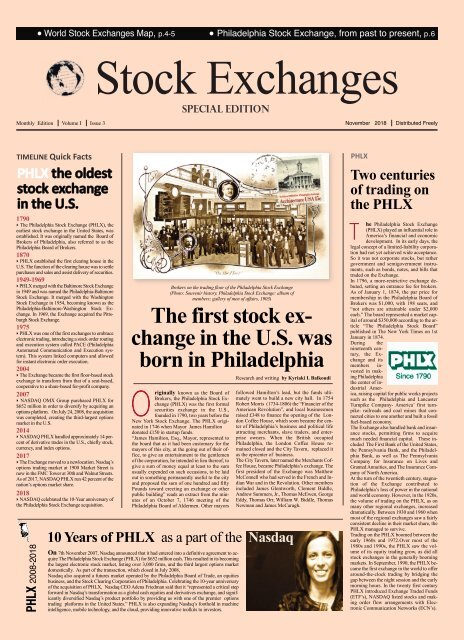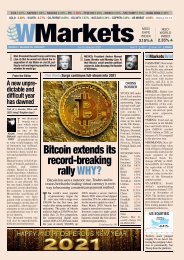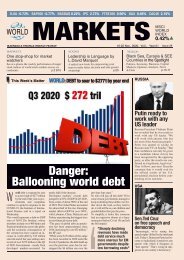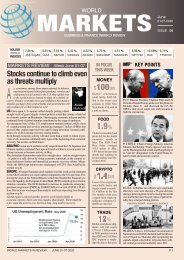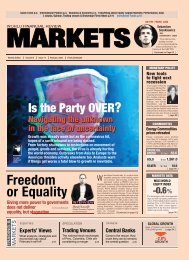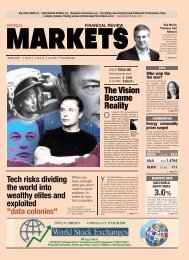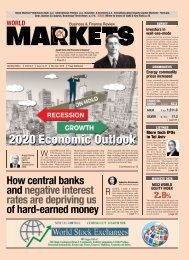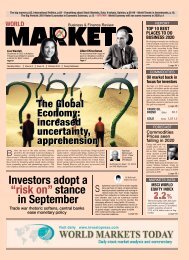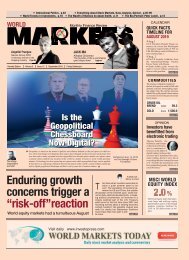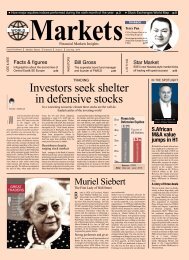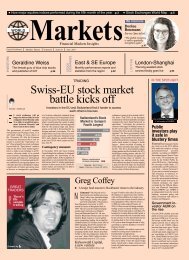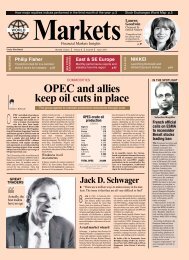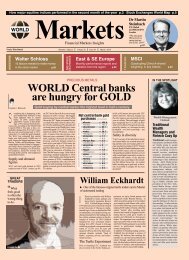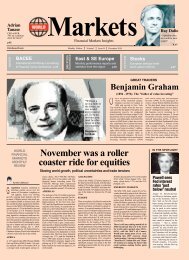Stock Exchanges Special Edition PHLX
Special Edition about the Philadelphia Stock Exchange
Special Edition about the Philadelphia Stock Exchange
Create successful ePaper yourself
Turn your PDF publications into a flip-book with our unique Google optimized e-Paper software.
IPress 3aaa_Layout 1 11/13/18 12:01 PM Page 29<br />
● World <strong>Stock</strong> <strong>Exchanges</strong> Map, p.4-5 ● Philadelphia <strong>Stock</strong> Exchange, from past to present, p.6<br />
<strong>Stock</strong> <strong>Exchanges</strong><br />
SPECIAL EDITION<br />
Monthly <strong>Edition</strong> ⎥ Volume I ⎥ Issue 3<br />
November 2018 ⎥ Distributed Freely<br />
TIMELINE Quick Facts<br />
<strong>PHLX</strong> the oldest<br />
stock exchange<br />
in the U.S.<br />
1790<br />
‣ The Philadelphia <strong>Stock</strong> Exchange (<strong>PHLX</strong>), the<br />
earliest stock exchange in the United States, was<br />
established. It was originally named the Board of<br />
Brokers of Philadelphia, also referred to as the<br />
Philadelphia Board of Brokers.<br />
1870<br />
‣ <strong>PHLX</strong> established the first clearing house in the<br />
U.S. The function of the clearing house was to settle<br />
purchases and sales and assist delivery of securities.<br />
1949-1969<br />
‣ <strong>PHLX</strong> merged with the Baltimore <strong>Stock</strong> Exchange<br />
in 1949 and was named the Philadelphia-Baltimore<br />
<strong>Stock</strong> Exchange. It merged with the Washington<br />
<strong>Stock</strong> Exchange in 1954, becoming known as the<br />
Philadelphia-Baltimore-Washington <strong>Stock</strong> Exchange.<br />
In 1969, the Exchange acquired the Pittsburgh<br />
<strong>Stock</strong> Exchange.<br />
1975<br />
‣ <strong>PHLX</strong> was one of the first exchanges to embrace<br />
electronic trading, introducing a stock order routing<br />
and execution system called PACE (Philadelphia<br />
Automated Communication and Execution system).<br />
This system linked computers and allowed<br />
for instant electronic order execution.<br />
2004<br />
‣ The Exchange became the first floor-based stock<br />
exchange to transform from that of a seat-based,<br />
cooperative to a share-based for-profit company.<br />
2007<br />
‣ NASDAQ OMX Group purchased <strong>PHLX</strong> for<br />
$652 million in order to diversify by acquiring an<br />
options platform. On July 24, 2008, the acquisition<br />
was completed, creating the third-largest options<br />
market in the U.S.<br />
2014<br />
‣ NASDAQ <strong>PHLX</strong> handled approximately 14 percent<br />
of derivative trades in the U.S., chiefly stock,<br />
currency, and index options.<br />
2017<br />
‣ The Exchange moved to a newlocation. Nasdaq’s<br />
options trading market at 1900 Market Street is<br />
now in the FMC Tower at 30th and Walnut Streets.<br />
As of 2017, NASDAQ <strong>PHLX</strong> run 42 percent of the<br />
nation’s options market share.<br />
2018<br />
‣ NASDAQ celebrated the 10-Year anniversary of<br />
the Philadelphia <strong>Stock</strong> Exchange acquisition.<br />
<strong>PHLX</strong> 2008-2018<br />
Brokers on the trading floor of the Philadelphia <strong>Stock</strong> Exchange<br />
(Photo: Souvenir history, Philadelphia <strong>Stock</strong> Exchange: album of<br />
members; gallery of men of affairs, 1903)<br />
The first stock exchange<br />
in the U.S. was<br />
born in Philadelphia<br />
O<br />
riginally known as the Board of<br />
Brokers, the Philadelphia <strong>Stock</strong> Exchange<br />
(<strong>PHLX</strong>) was the first formal<br />
securities exchange in the U.S.,<br />
founded in 1790, two years before the<br />
New York <strong>Stock</strong> Exchange. The <strong>PHLX</strong> originated<br />
in 1746 when Mayor James Hamilton<br />
donated £150 in startup funds.<br />
“James Hamilton, Esq., Mayor, represented to<br />
the board that as it had been customary for the<br />
mayors of this city, at the going out of their office,<br />
to give an entertainment to the gentlemen<br />
of the corporation, he intended in lieu thereof, to<br />
give a sum of money equal at least to the sum<br />
usually expended on such occasions, to be laid<br />
out in something permanently useful to the city<br />
and proposed the sum of one hundred and fifty<br />
Pounds toward erecting an exchange or other<br />
public building” reads an extract from the minutes<br />
of an October 7, 1746 meeting of the<br />
Philadelphia Board of Aldermen. Other mayors<br />
On 7th November 2007, Nasdaq announced that it had entered into a definitive agreement to acquire<br />
The Philadelphia <strong>Stock</strong> Exchange (<strong>PHLX</strong>) for $652 million cash. This resulted in its becoming<br />
the largest electronic stock market, listing over 3,000 firms, and the third largest options market<br />
domestically. As part of the transaction, which closed in July 2008,<br />
Nasdaq also acquired a futures market operated by the Philadelphia Board of Trade, an equities<br />
business, and the <strong>Stock</strong> Clearing Corporation of Philadelphia. Celebrating the 10-year anniversary<br />
of the acquisition of <strong>PHLX</strong>, Nasdaq CEO Adena Friedman said that it “represented a critical step<br />
forward in Nasdaq’s transformation as a global cash equities and derivatives exchange, and significantly<br />
diversified Nasdaq’s product portfolio by providing us with one of the premier options<br />
trading platforms in the United States.” <strong>PHLX</strong> is also expanding Nasdaq’s foothold in machine<br />
intelligence, mobile technology, and the cloud, providing innovative toolkits to investors.<br />
Research and writing by Kyriaki I. Balkoudi<br />
followed Hamilton’s lead, but the funds ultimately<br />
went to build a new city hall. In 1754<br />
Robert Morris (1734-1806) the “Financier of the<br />
American Revolution”, and local businessmen<br />
raised £348 to finance the opening of the London<br />
Coffee House, which soon became the center<br />
of Philadelphia’s business and political life<br />
attracting merchants, slave traders, and enterprise<br />
owners. When the British occupied<br />
Philadelphia, the London Coffee House remained<br />
closed and the City Tavern, replaced it<br />
as the epicenter of business.<br />
The City Tavern, later named the Merchants Coffee<br />
House, became Philadelphia’s exchange. The<br />
first president of the Exchange was Matthew<br />
McConnell who had served in the French and Indian<br />
War and in the Revolution. Other members<br />
included James Glentworth, Clement Biddle,<br />
Andrew Summers, Jr., Thomas McEwen, George<br />
Eddy, Thomas Orr, William W. Biddle, Thomas<br />
Newman and James McCaragh.<br />
10 Years of <strong>PHLX</strong> as a part of the Nasdaq<br />
<strong>PHLX</strong><br />
Two centuries<br />
of trading on<br />
the <strong>PHLX</strong><br />
T<br />
he Philadelphia <strong>Stock</strong> Exchange<br />
(<strong>PHLX</strong>) played an influential role in<br />
America’s financial and economic<br />
development. In its early days, the<br />
legal concept of a limited-liability corporation<br />
had not yet achieved wide acceptance.<br />
So it was not corporate stocks, but rather<br />
government and semigovernment instruments,<br />
such as bonds, notes, and bills that<br />
traded on the Exchange.<br />
In 1796, a more-restrictive exchange debuted,<br />
setting an entrance fee for brokers.<br />
As of January 1, 1874, the par price for<br />
membership in the Philadelphia Board of<br />
Brokers was $1,000, with 198 seats, and<br />
“not others are attainable under $2,000<br />
each.” The board represented a market capital<br />
of around $350,000 according to the article<br />
“The Philadelphia <strong>Stock</strong> Board”<br />
published in The New York Times on 1st<br />
January in 1874.<br />
During the<br />
nineteenth century,<br />
the Exchange<br />
and its<br />
members invested<br />
in making<br />
Philadelphia<br />
the center of industrial<br />
America,<br />
raising capital for public works projects<br />
such as the Philadelphia and Lancaster<br />
Turnpike Company- America’ first turnpike-<br />
railroads and coal mines that connected<br />
cities to one another and built a fossil<br />
fuel-based economy.<br />
The Exchange also handled bank and insurance<br />
stocks, permitting firms to acquire<br />
much needed financial capital. These included<br />
The First Bank of the United States,<br />
the Pennsylvania Bank, and the Philadelphia<br />
Bank, as well as The Pennsylvania<br />
Company for Insurance on Lives and<br />
Granted Annuities, and The Insurance Company<br />
of North America.<br />
At the turn of the twentieth century, stagnation<br />
of the Exchange contributed to<br />
Philadelphia’s loss of power in the national<br />
and world economy. However, in the 1920s,<br />
the volume of trading on the <strong>PHLX</strong>, as on<br />
many other regional exchanges, increased<br />
dramatically. Between 1930 and 1960 when<br />
most of the regional exchanges saw a fairly<br />
consistent decline in their market share, the<br />
<strong>PHLX</strong> managed to survive.<br />
Trading on the <strong>PHLX</strong> boomed between the<br />
early 1960s and 1972.Over most of the<br />
1980s and 1990s, the <strong>PHLX</strong> saw the volume<br />
of its equity trading grow, as did all<br />
stock exchanges in the generally booming<br />
markets. In September, 1990, the <strong>PHLX</strong> became<br />
the first exchange in the world to offer<br />
around-the-clock trading by bridging the<br />
gap between the night session and the early<br />
morning hours. In the twenty first century<br />
<strong>PHLX</strong> introduced Exchange Traded Funds<br />
(ETF’s), NASDAQ listed stocks and making<br />
order flow arrangements with Electronic<br />
Communication Networks (ECN’s).
IPress 3aaa_Layout 1 11/12/18 11:08 PM Page 30<br />
World <strong>Stock</strong> <strong>Exchanges</strong><br />
4 November 2018<br />
1AMERICAS<br />
2<br />
EUROPE<br />
NORTH AMERICA<br />
0. BAHAMAS Nassau BISX<br />
1. BARBADOS Saint Michael BSE<br />
2. BERMUDA Hamilton BSX<br />
3. CANADA Toronto TSX<br />
4. CAYMAN ISLANDS Grand Cayman SXE<br />
5. DOMINICAN REP. S.Domingo BVRD<br />
6. EL SALVADOR San Salvador BVES<br />
7. GUATEMALA Guatemala City BNV<br />
8. JAMAICA Kingston JSE<br />
9. MEXICO Mexico City BMV<br />
10. MEXICO Mexico City BIVA<br />
11. NICARAGUA Managua BVDN<br />
12. PANAMA Panama City BVP<br />
13. SAINT KITTS & NEVIS Basseterre ECSE<br />
14. TRINIDAD & TOBAGO P. of Spain TTSE<br />
15. UNITED STATES Chicago CHX<br />
16. UNITED STATES New York NASDAQ<br />
17. UNITED STATES New York NYSE<br />
SOUTH AMERICA<br />
18. ARGENTINA Buenos Aires BCBA<br />
19. BRAZIL Sao Paulo BOVESPA<br />
20. CHILE Santiago SSE<br />
21. COLOMBIA Bogota BVC<br />
22. .EQUADOR Quito BVQ<br />
23. .HONDURAS Tagucigalpa BVC<br />
24. PARAGUAY Asuncion BVPASA<br />
25. PERU Lima BVL<br />
26. URUGUAY Montevideo BVM<br />
27. VENEZUELA Caracas BVC<br />
46<br />
28. ALBANIA Tirana ALSE<br />
29. AUSTRIA Vienna WIENER BORSE<br />
30. BELARUS Minsk BCSE<br />
31. BELGIUM Brussels EURONEXT<br />
32. BOSNIA-HERZEG.Banja Luka BLSE<br />
32a.BOSNIA-HERZEG. Sarajevo SASE<br />
33. BULGARIA Sofia BSE<br />
34. CHANNEL ISLANDS Guernsey TISE<br />
35. CROATIA Zagreb ZSE<br />
36. CYPRUS Nicosia CSE<br />
37. CZECH REPUBLIC Prague PSE<br />
15<br />
NEW YORK CITY<br />
Nasaq <strong>PHLX</strong><br />
PHILADELPHIA<br />
16<br />
16 A<br />
TORONTO<br />
17<br />
2<br />
3<br />
NEW YORK CITY<br />
LONDON<br />
MADRID<br />
58<br />
47<br />
ZURICH<br />
102<br />
34<br />
43<br />
AMSTERDAM<br />
65<br />
70<br />
41<br />
86<br />
STOCKHOLM<br />
56<br />
66<br />
38<br />
55 42<br />
FRANKFU<br />
31 42a 37 57<br />
51<br />
29 63 67 64 45<br />
67a<br />
48 35 5462<br />
32a<br />
32<br />
5<br />
28<br />
114<br />
53<br />
98<br />
0<br />
10<br />
*<br />
9<br />
7<br />
6<br />
11<br />
23<br />
12<br />
4 5 13<br />
8<br />
1<br />
21<br />
27<br />
14<br />
24<br />
26<br />
89<br />
*<br />
*<br />
*<br />
91<br />
*<br />
*<br />
95<br />
*<br />
105<br />
*<br />
106<br />
90<br />
**<br />
**<br />
World<br />
<strong>Stock</strong><br />
<strong>Exchanges</strong><br />
Map<br />
This map shows the stock exchanges around the<br />
world. The 20 largest by market capitalization of listed<br />
companies are marked with their logo, the city they are<br />
located and a bold number in a circle. All are presented<br />
in alphabetical order by continent, country and<br />
city. As of August 2018, the NYSE ranked as the largest<br />
by market capitalisation with a value of tradable<br />
shares amounting to 24.23 trillion U.S. dollars.<br />
WORLD STOCK EXCHANGES<br />
published by<br />
EuropaProPress Ltd<br />
42 Marasesti Blv.<br />
Bl.1, Sc.A, 2nd fl., Ap.7,<br />
04255 District 4, Bucharest,<br />
Romania<br />
Commerce Registry Code: J40/12206/2016<br />
Tel.+40 314.228.321<br />
www.investopress.com<br />
22<br />
25<br />
20<br />
18<br />
19<br />
SAO PAULO<br />
5<br />
AFRICA<br />
84. SOUTH SUDAN Juba To be launched<br />
85. ETHIOPIA Addis Ababa ECX<br />
86. ALGERIA Algiers IL BOURSA<br />
87. ANGOLA Luanda BOVIDA<br />
88. BOTSWANA Gaborone BSE<br />
89. CAPE VERDE Mindelo BVC<br />
90. CAMEROON Duala DSX<br />
91. COTE D'IVOIRE Abidjan BRVM *<br />
92. EGYPT Alexandria EGX<br />
93. EGYPT Cairo EGX<br />
94. GABONE Libreville BVMAC **<br />
95. GHANA Accra GSE<br />
96. KENYA Nairobi NSE<br />
97 LESOTHO Maseru MSM<br />
98. LIBYA Tripoli LSM<br />
99. MADAGASCAR Antananarivo MEX<br />
100. MALAWI Blantyre MSE<br />
101. MAURITIUS Port Louis SEM<br />
102. MOROCCO Casablanca CASA SE<br />
103. MOZAMBIQUE Maputo BVM<br />
104. NAMIBIA Windhoek NSX<br />
105. NIGERIA Abuja ASCE<br />
106. NIGERIA Lagos NSE<br />
107. RWANDA Kigali RSE<br />
108. SEYCHELLES Victoria SSE<br />
109. SOMALIA Mogadishu SSE<br />
110. SOUTH AFRICA Johannesburg JSE<br />
111. SUDAN Khartoum KSE<br />
112. SWAZILAND Mbabane SSX<br />
113. TANZANIA Dar Es Salaam DSE<br />
114. TUNISIA Tunis BVMT<br />
115. UGANDA Kampala USE<br />
116. UGANDA Kampala ALTX<br />
117. ZAMBIA Lusaka LUSE<br />
118. ZIMBABWE Harare ZSE<br />
**<br />
94<br />
**<br />
87<br />
104<br />
110<br />
AFRICA<br />
*<br />
o<br />
t<br />
s<br />
*<br />
d<br />
v<br />
C<br />
G
IPress 3aaa_Layout 1 11/12/18 11:09 PM Page 31<br />
November 2018 World <strong>Stock</strong> <strong>Exchanges</strong><br />
5<br />
3<br />
EURASIA<br />
E<br />
SE<br />
E<br />
SE<br />
LM<br />
**<br />
38. DENMARK Copenhagen NASDAQ<br />
39. ESTONIA Tallinn NASDAQ<br />
40. FINLAND Helsinki NASDAQ<br />
41. FRANCE Paris EURONEXT<br />
42. GERMANY Frankfurt FWB<br />
42a.GERMANY Hamburg BOERSE<br />
43. GIBRALTAR Europort GSX<br />
44. GREECE Athens ATHEX<br />
45. HUNGARY Budapest BSE<br />
46 ICELAND Reykjavik NASDAQ<br />
47. IRELAND Dublin EURONEXT<br />
40<br />
61<br />
39<br />
50 60<br />
30<br />
NKFURT<br />
57<br />
69<br />
3<br />
45<br />
62 59<br />
32<br />
a 33<br />
52<br />
28<br />
68<br />
44<br />
36 78<br />
76 75<br />
80 73 74<br />
92<br />
77<br />
93<br />
72<br />
82 81<br />
83<br />
111<br />
71<br />
69 70<br />
79<br />
48. ITALY Milan BORSA ITALIANA<br />
49. LATVIA Riga NASDAQ<br />
50. LITHUANIA Vilnius NASDAQ<br />
51. LUXEMBOURG Lux/urg City LUXSE<br />
52. MACEDONIA Skopje MSE<br />
53. MALTA Valletta MSE<br />
54. MONTENEGRO Podgorica MNSE<br />
55. NETHERLANDS AmsterdamEuRONEXT<br />
56. NORWAY Oslo OSLO BORS<br />
57. POLAND Warsaw GPW<br />
58. PORTUGAL Lisbon EURONEXT<br />
133<br />
152<br />
142<br />
143<br />
134<br />
150<br />
144<br />
127<br />
128<br />
141<br />
MUMBAI<br />
MUMBAI<br />
120<br />
138<br />
122<br />
121<br />
139<br />
59. ROMANIA Bucharest BVB<br />
60. RUSSIA Moscow MOEX<br />
61. RUSSIA Saint Petersburg SPB<br />
62. SERBIA Belgrade BSE<br />
63. SLOVAKIA Bratislava BSSE<br />
64. SLOVENIA Ljubljana LJSE<br />
65. SPAIN Madrid BME<br />
66. SWEDEN <strong>Stock</strong>holm NASDAQ<br />
67. SWITZERLAND Zurich SIX<br />
67a. SWITZERLAND Bern BX SWISS<br />
69. TURKEY Istanbul BORSA ISTANBUL<br />
SHENZHEN<br />
SHANGHAI<br />
135<br />
151<br />
123<br />
125 147<br />
153<br />
124<br />
126<br />
BUSAN<br />
149<br />
136<br />
130<br />
131<br />
132<br />
HONG KONG<br />
TAIPEI<br />
4<br />
69. ARMENIA Yerevan NASDAQ<br />
70. AZERBAIJAN Baku BSE<br />
71. GEORGIA Tbilisi GSE<br />
MIDDLE EAST<br />
72. BAHRAIN Manama BHB<br />
73. JORDAN Amman ASE<br />
74. IRAN Tehran TSE<br />
75. IRAQ Baghdad ISX<br />
76. ISRAEL Tel Aviv TASE<br />
77. KUWAIT Kuwait City BK<br />
78. LEBANON Beirut BSE<br />
79. OMAN Muscat MSM<br />
80. PALESTINE Ramallah PEX<br />
81. QATAR Doha QSE<br />
82. SAUDI ARABIA Riyadh TADAWUL<br />
83. UAE Abu Dhabi ADX<br />
TOKYO<br />
**<br />
**<br />
88<br />
117<br />
97<br />
84<br />
107<br />
118<br />
116<br />
115<br />
100<br />
103<br />
112<br />
113<br />
JOHANNESBURG<br />
85<br />
96<br />
99<br />
109<br />
108<br />
101<br />
* The Bourse Régionale des Valeurs Mobilières,<br />
or BRVM, located in Abidjan, Cote d'Ivoire serves<br />
the countries of Benin, Burkina Faso, Guinea Bissau,<br />
Côte d'Ivoire, Mali, Niger, Senegal and Togo.<br />
** The Bourse Régionale des Valeurs Mobilières<br />
d'Afrique Centrale, orBVMAC, located in Libreville,<br />
Gabon serves the Central African Republic,<br />
Chad, Democratic Republic of Congo, Equatorial<br />
Guinea and Gabon.<br />
6<br />
137<br />
148<br />
ASIA PACIFIC<br />
119. AUSTRALIA Sydney ASX<br />
120. BANGLADESH Dhaka DSE<br />
121. BANGLADESH Chittagong CSE<br />
122. BHUTAN Thimphu RSEBL<br />
123. CAMBODIA Phom Penh CSX<br />
124. CHINA Shanghai SSE<br />
125. CHINA Shenzhen SZSE<br />
126. HONG KONG Hong Kong HKEX<br />
127. INDIA Mumbai NSE<br />
128. INDIA Mumbai BSE<br />
129. INDONESIA Jakarta IDX<br />
130. JAPAN Fukuoka FSE<br />
131. JAPAN Nagoya NSE<br />
132. JAPAN Tokyo TSE<br />
133. KAZAKHSTAN Almaty KASE<br />
134. KYRGYZSTAN Bishkek KSE<br />
135. LAOS Vientiane LSX<br />
136. MALAYSIA Kuala Lumpur BM<br />
137. MALDIVES Male MSE<br />
138. MONGOLIA Ulaanbaatar MSE<br />
139. MYANMAR Vientiane LSX<br />
140. NEW ZEALAND Wellington NZX<br />
141. NEPAL Kathmandu NEPSE<br />
142. PAKISTAN Karachi PSE<br />
143. PAKISTAN Lahore PSE<br />
144. PAKISTAN Islamabad PSE<br />
145. PHILIPPINES Manila PSE<br />
146. SINGAPORE Singapore SGX<br />
147. SOUTH KOREA Busan KREX<br />
148. SRI LANKA Colombo CSE<br />
149. TAIWAN Taipei TPEX<br />
150. TAJIKISTAN Dushanbe CASE<br />
151. THAILAND Bangkong SET<br />
152. UZBEKISTAN Tashkent UZSE<br />
153. VIETNAM Ho Chi Minh City HOSE<br />
145<br />
146<br />
129<br />
SYDNEY<br />
119<br />
140<br />
For any corrections regarding the<br />
stock exchanges on this map contact:<br />
editorial@investopress.com
IPress 3aaa_Layout 1 11/12/18 11:07 PM Page 28<br />
6<br />
LAST PAGE<br />
November 2018<br />
HEADQUARTERS<br />
Locations of the<br />
Philadelphia<br />
<strong>Stock</strong> Exchange<br />
From the Merchants' Coffee<br />
House to the FMC Tower<br />
Over its 228 years the Philadephia <strong>Stock</strong> Exchange<br />
(<strong>PHLX</strong>) has had a variety of names<br />
and office locations.<br />
At its founding in 1790, the Board of Brokers was located<br />
in the City Tavern- a place frequented by the<br />
Founding Fathers of the United States and other distinctive<br />
people- at the corner of Second and Walnut<br />
Streets. Members of the Philadelphia Exchange met<br />
at City Tavern so frequently it was often referred to<br />
as the Merchants' Coffee House. This building was<br />
severely damaged by a fire in 1834, but fortunately,<br />
in 1831, Stephen Girard (1750-1831), the nation's<br />
wealthiest man at the time, formed the Philadelphia<br />
Merchants’ Exchange Company with the intention of<br />
erecting a new building to house the Board of Brokers<br />
and other groups.<br />
In 1832, the Exchange began to build its headquarters<br />
based on drawings by architect William Strickland .<br />
The Board of Brokers moved into the Merchants Exchange<br />
Building at 3rd and Dock Streets in 1834 following<br />
the fire at the Merchants Coffee House. Built<br />
between 1832 and 1834, the Merchants’ Exchange<br />
Building has been declared a National Historic Landmark.<br />
In 1876, the Philadelphia <strong>Stock</strong> Exchange<br />
moved to the rear of the Girard Bank Building, formerly<br />
the First Bank of the U.S.where it stayed until<br />
1888. In 1888, the Exchange moved to the Drexel<br />
Building which was demolished in 1959 to make way<br />
for the new Library Hall. Between 1902 and 1912, the<br />
Exchange returned to the Merchants Exchange<br />
Building.<br />
In 1913, it moved to a building at 1411 Walnut St. In<br />
1951, it moved to the Central Penn Bank Building at<br />
1401 Walnut Street. It stayed there until 1966 when it<br />
moved to a newly constructed building at 17th and<br />
Sansom. In December 1968, the City of Philadelphia<br />
faced a fiscal crisis, resulting in a a 5-cent-per-share<br />
stock-transfer tax imposed on every transaction on the<br />
<strong>PHLX</strong>. In reply, on 2nd January 1969, the Exchange<br />
moved its trading floor to Bala<br />
Cynwyd, just outside Philadelphia’s<br />
border to avoid the tax.<br />
Three months later, a state<br />
court ruled that the tax was illegal,<br />
and the <strong>PHLX</strong> returned<br />
to Philadelphia. In<br />
1981, the <strong>PHLX</strong> moved to<br />
a location at an office<br />
building at Market and<br />
Nineteenth Streets in<br />
Center City where it<br />
stayed until 2017<br />
when it moved to its<br />
current location.<br />
Photo:<br />
FMC Tower,<br />
<strong>PHLX</strong> Nasdaq<br />
headquarters<br />
WORLD MARKETS<br />
The rich history<br />
of the first U.S.<br />
securities exchange<br />
❥ As the financial community continues to evolve,<br />
<strong>PHLX</strong> continues to hold its proud place in the<br />
capital markets<br />
T<br />
he Philadelphia <strong>Stock</strong> Exchange<br />
(<strong>PHLX</strong>) dates its founding to 1790,<br />
making it the oldest organised stock exchange<br />
in the U.S. and the third-oldest<br />
globally, after the Amsterdam Exchange<br />
(1602) and Paris Bourse (1724). In fact, the earliest<br />
known record of securities quotations in the<br />
United States is the "Price Current of <strong>Stock</strong>s,"<br />
printed on three-by-six inch paper and signed by<br />
Samuel Anderson, <strong>Stock</strong> Broker, at Number 104<br />
Chestnut Street, Philadelphia. It is dated April 10,<br />
1792. The Exchange provided an efficient source<br />
of capital for needed public works, such as the<br />
Pennsylvania Railroad and the Philadelphia Railway,<br />
utility systems, canals and real estate development.<br />
It also helped the nation raise funds<br />
to establish new commercial banks and insurance<br />
companies.<br />
Starting in 1846, the telegraph allowed investors<br />
to have quick access to stock quotes and news,<br />
bringing a new openness to the business of the<br />
Exchange. <strong>PHLX</strong> closed for four months in 1914<br />
because of World War I market turmoil. It also<br />
closed during the 1933 Bank Holiday. Following<br />
World War II, the Exchange began to reach out<br />
beyond Philadelphia, growing through mergers.<br />
Philadelphia merged with the Baltimore <strong>Stock</strong><br />
Exchange in 1949, and with the Washington<br />
(D.C.) <strong>Stock</strong> Exchange in 1953. Through associate<br />
membership agreements, Philadelphia expanded<br />
its trading base to Pittsburgh, Boston, and<br />
Montreal. From 1953- 1976 the exchange was<br />
called the Philadelphia-Baltimore-Washington<br />
<strong>Stock</strong> Exchange (PBW).<br />
A<br />
n increasing use of computers during the<br />
1960's and 1970's changed every business,<br />
and Philadelphia was among the<br />
first exchanges to engage in electronic<br />
trading. In 1975, <strong>PHLX</strong> introduced a<br />
computerized order-handling and execution system<br />
called PACE (Philadelphia Automated Communication<br />
and Execution System). PACE would<br />
NASDAQ <strong>PHLX</strong> on the cutting<br />
edge of technology<br />
provide electronic execution of stock orders instantly.<br />
In the same year the <strong>PHLX</strong> began to trade<br />
options on equities, the third exchange doing so,<br />
after the Chicago Board Options Exchange<br />
(CBOE) and the American <strong>Stock</strong> Exchange<br />
(AMEX). In 1976, its Board of Governors restored<br />
its original name, the Philadelphia <strong>Stock</strong><br />
Exchange. On 27th February 1976 exchange vice<br />
president Gordon Yocum explained to the<br />
Philadelphia Inquirer, “While the acronym<br />
[PBW] suited us, the board felt we needed a<br />
name more appropriate for our...history.”<br />
I<br />
In December 1982, the <strong>PHLX</strong> opened its<br />
currency options trading floor. By 1988,<br />
currency options were trading in volumes<br />
as high as $4 billion per day in underlying<br />
value. The introduction of Sector Index<br />
Options in the 1990s, consisting of indexes such<br />
as the Gold/Silver Sector (XAU), KBW Bank<br />
Index (BKX), Utility Sector (UTY), and Insurance<br />
Index (KIX), made <strong>PHLX</strong> an industry<br />
leader in sectors index options trading by allowing<br />
investors to use options trading for diverse industries<br />
and commodities. The exchange grew<br />
even more through the creation of UCOM<br />
(United Currency Options Market) in November<br />
1994. UCOM was the first market in the world<br />
to offer customisable currency options in an exchange<br />
environment.<br />
In the twenty first century <strong>PHLX</strong> introduced Exchange<br />
Traded Funds (ETF's), NASDAQ listed<br />
stocks and making order flow arrangements with<br />
Electronic Communication Networks (ECN's).<br />
In a major move in 2006, the exchange halted the<br />
traditional floor trading that started in 1790.<br />
During its more than 200 years of history, <strong>PHLX</strong>,<br />
as one of North America’s primary marketplaces<br />
has held on to its determination to provide an efficient<br />
and transparent service to its listed companies,<br />
brokers and investors, encompassing new<br />
ideas and solutions.<br />
■ NASDAQ <strong>PHLX</strong>, Inc. trades on equity<br />
options, index options, and U.S. dollarsettled<br />
currency options. It offers equity<br />
options; various derivatives offerings,<br />
including FX options<br />
providing retail and institutional<br />
traders with the opportunity to<br />
trade options on major foreign<br />
currencies; and sector index<br />
options. The company also<br />
distributes market data products,<br />
including futures<br />
trading market data and<br />
sector index spot and settlement<br />
values data. It provides electronic<br />
and floor-based trade.<br />
■ NASDAQ <strong>PHLX</strong>, Inc. operates<br />
as a subsidiary of Nasdaq Inc., the<br />
creator of the world's first electronic<br />
stock market. Its technology<br />
powers more than 70<br />
marketplaces in 50 countries, and 1<br />
in 10 of the world's securities transactions.<br />
Nasdaq is home to more than<br />
3,600 listed companies with a market<br />
value of approximately $9.6 trillion.<br />
References: ● John P. Caskey, “The Evolution of the Philadelphia <strong>Stock</strong> Exchange: 1964-<br />
2002,” Federal Reserve Bank of Philadelphia Working Paper 03-21, August 2003. ● Domenic Vitiello<br />
with George E. Thomas, “The Philadelphia <strong>Stock</strong> Exchange and the City It Made”, University<br />
of Pennsylvania Press, 2010 ● Philadelphia <strong>Stock</strong> Exchange Papers (1746-2005), Collection 3070,<br />
The Historical Society of Pennsylvania, 2006 ● E.P. Goodman, "History of the Philadelphia <strong>Stock</strong><br />
Exchange", Press of the Northern Printing House, 1903.<br />
PHOTO-Archive<br />
<strong>PHLX</strong>,<br />
from past to<br />
present<br />
The Philadelphia <strong>Stock</strong> Exchange, an occasionally<br />
mobile institution, migrated among the<br />
First Bank of the United States, the Sofitel<br />
tower and other landmarks since its founding at<br />
City Tavern.<br />
London Coffee House<br />
Lithograph by Kennedy & Lucas depicting the<br />
London Coffee House, the centre of Philadelphia’s<br />
business life, as it stood in 1830.<br />
Merchants' Exchange<br />
Building (A)<br />
Employing mainly marble, architect William<br />
Strickland (1788-1854), based the design on<br />
classical Greek models.<br />
Merchants' Exchange<br />
Building (B)<br />
The front of the Merchants’ Exchange Building,<br />
located on the triangular site bounded by Dock<br />
Street, Third Street, and Walnut Street.<br />
Board Room<br />
The Board Room of the Merchants' Exchange<br />
Building. Pictures from Souvenir History<br />
Philadelphia <strong>Stock</strong> Exchange


